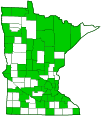Forage looper moth
(Caenurgina erechtea)
Conservation • Description • Habitat • Ecology • Distribution • Taxonomy
| Hodges # | 8739 |
||
Conservation Status |
|||
| IUCN Red List | not listed |
||
| NatureServe | N5 - Secure |
||
| Minnesota | not listed |
||
Description |
Forage looper moth is a medium-sized, widespread and very common moth. It occurs throughout the United States, in adjacent Canadian provinces and Mexican states, and in China. It is very common in Minnesota. It is found in grasslands, meadows, old fields, and roadsides. It is often abundant in clover fields. Adults are ⅝″ to ⅞″ (17 to 23 mm) long and have a wingspan of 1 3 ⁄16″ to 1⅝″ (30 to 42 mm). Females are larger and are colored differently than males. There are several broods each year from late April through September. Individuals in the summer broods are larger than those of the spring broods. The forewing ground color of the male is pale bluish-gray. The terminal area is darker gray. A broad, oblique, brownish-black band in the antemedial area (AM band) curves toward the rear well before the inner margin. It ends close to but never reaches the inner margin. A similar but straight band in the postmedial area (PM band) ends well before the inner margin. The two bands do not meet. Two spots are important identifying features in many moths. The orbicular spot, in the upper median area, is a small, circular, dark gray dot. The reniform spot, in the lower median area, is large but not apparent. It is fused to and the same color as the PM band. There is a row of dark spots just before the subterminal area. The outer two spots are large, very dark, and sometimes fused together. The remaining spots are small and inconspicuous. The hindwings are light grayish-yellow with darker postmedial and submarginal bands and a dark terminal line. The antennae have a fringe of short hairs (ciliate). On the female, the forewing color is pale reddish-brown and the dark areas are dark brown. The hindwings are more orangish. The thorax of both sexes is the same color as the ground color of the forewings. The antennae are not ciliate. The caterpillar is slender and up to 1 9 ⁄16″ (4 cm) long. It is highly variable in color and pattern, but is often tan to pale brown and striped. On the upper middle area there is a stripe (middorsal stripe) that consists of a thin white stripe that is bordered with an inner tan to reddish-brown stripe and an outer white stripe. On each side below the breathing pores (spiracles) there is a stripe (subspiracular stripe) that consists of a beige stripe bordered with two pale stripes. The middorsal and subspiracular stripes both extend onto the head. The subspiracular stripes extend to the antennae. |
Size |
Total length: ⅝″ to ⅞″ (17 to 23 mm) Wingspan: 1 3 ⁄16″ to 1⅝″ (30 to 42 mm) |
Similar Species |
Clover looper moth (Caenurgina crassiuscula) is always brown, never gray. On the forewing the AM band touches the inner margin. The AM and PM bands converge at the inner margin. |
Habitat |
Grasslands, meadows, old fields, roadsides |
Ecology |
Season |
Several generations per year: Late April to November |
Behavior |
Adults are active both day and night. Both sexes are attracted to lights. |
Life Cycle |
Pupae overwinter |
Larva Hosts |
Mostly plants in the pea (Fabaceae) family, especially clover, but also giant ragweed and grasses. |
Adult Food |
|
Distribution |
||
|
Sources 7, 21, 24, 27, 29, 30, 71, 75, 82, 83. Biodiversity occurrence data published by: Minnesota Biodiversity Atlas (accessed through the Minnesota Biodiversity Atlas Portal, bellatlas.umn.edu, 9/24/2025). |
|
| 9/24/2025 | ||
Occurrence |
||
Very common and widespread |
||
Taxonomy |
|
Order |
|
Superfamily |
Noctuoidea (Owlet Moths and Allies) |
Family |
Erebidae (Underwing, Tiger, Tussock, and Allied Moths) |
Subfamily |
Erebinae (underwings, zales, and related owlets) |
Tribe |
Euclidiini |
Genus |
Caenurgina |
This genus and species was formerly included in the family Arctiidae. A molecular phylogenetic study on the noctuid moths (Superfamily Noctuidea) published in 2005 clarified the relationships of the noctuid moths and resulted in a reshuffling of the families and subfamilies. The current classification places this genus and species in the family Erebidae. |
|
Subordinate Taxa |
|
|
|
Synonyms |
|
Caenurgina agricola Caenurgina mundula Caenurgina narrata Caenurgina parva Caenurgina patibilis |
|
Common Names |
|
common grass moth forage looper forage looper moth |
|
Glossary
Orbicular spot
A circular spot or outline in the upper median area near the antemedial line on the forewing of many moths.
Reniform spot
A kidney-shaped spot or outline in the lower median area near the PM line on the forewing of many moths.
Spiracle
A small opening on the surface of an insect or arachnid through which it breathes.
Visitor Photos
Share your photo of this insect.
This button not working for you?
Simply email us at info@MinnesotaSeasons.com.
Attach one or more photos and, if you like, a caption.
Alfredo Colon |
 |
Dan W. Andree |
||
Forage Looper Moth... Funny little head and eyes on it. |
||
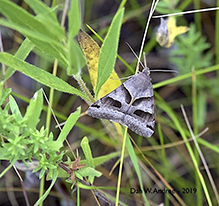 |
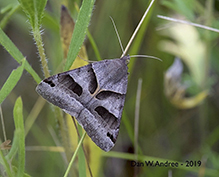 |
|
MinnesotaSeasons.com Photos
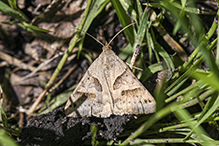 |
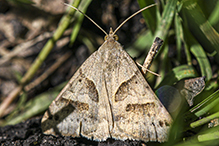 |
|
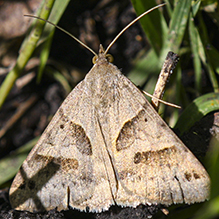 |

Slideshows
Forage Looper (Caenurgina erechtea) Close-up
Carl Barrentine

Visitor Videos
Share your video of this insect.
This button not working for you?
Simply email us at info@MinnesotaSeasons.com.
Attach a video, a YouTube link, or a cloud storage link.
Other Videos
Forage Looper (Caenurgina erechtea) Close-up
Carl Barrentine
Caenurgina erechtea
wetvideocamera
Forage Looper Moth (Erebidae: Caenurgina erechtea) in Grass
Carl Barrentine

Visitor Sightings
Report a sighting of this insect.
This button not working for you?
Simply email us at info@MinnesotaSeasons.com.
Be sure to include a location.
Minnesota Seasons Sightings

